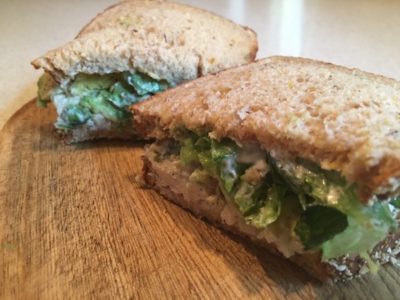
Can you think of your story as a sandwich? Have I lost my mind? Probably. But it’s been a while since breakfast.
Let’s think about the two pieces of bread as the beginning and end of your story. They need to be appealing, satisfying, and somewhat sturdy if they are going to support whatever fillings you place between them. It can be wheat or rye, thick or thin. The choice is yours.
I’m going with multi-grain bread for my story-supporters. There’s a lot of interesting detail, and it’s got enough heft to support what’s coming next. It happens to be perfect for the kind of story I’m going to tell. Once you’ve selected your bread, you need to consider what’s going to go inside your sandwich. The fillings become the rest of your story – what happens between the beginning and the end.
If you choose butter and nothing else, your readers may be left wanting more. Picture your reader lifting the corner of the bread and giving you a quizzical look. It may be rich, hand-churned butter, and it may taste delicious. But it might not be enough.
I’m going with mayonnaise in my story sandwich because I know it will go with what’s coming next. On one slice, it will be my “everyday world” where I introduce my characters and provide a background to the story. The mayo on the other slice will hold the fillings in place so the story doesn’t end too quickly.
What’s next? Meat (or whatever you want to substitute for meat). This the main ingredient in my story sandwich. The slices represent the main characters and the smaller pieces are minor characters, atmosphere, setting, etc. How I arrange them determines the plot of the story. Who’s placed next to who? Someone positioned on the edge may be the first to go! Now I need to flesh them out and bring them to life. They need to think, feel, and react. They need to be real.
Bring on the avocado! It’s rich, flavorful, and enhances every character in a way that is suited to their individual personality. Your character can be soft and gentle, or a smooth operator. Avocados are very versatile.
What’s next? Ah – lettuce! It adds the unexpected crunch of plot twists and turns. It adds juicy details like a shadowed past or something painful a character may be reluctant to reveal for reasons known only to him/her.
Last, a little salt and pepper to spice things up a bit. Steal a kiss in a quiet alcove or stage a confrontation outside the bar! Let your characters get into a fight and then make up – or not. Use sparingly – too much can overwhelm the reader and keep them from getting back to what the story is really about.
Satisfied? Set that other slice on top and gently press it all together. Okay, time for lunch. Chew on that for a while.

Elle Andrews Patt
Great metaphor! I like the lettuce crunch of plot twists and turns :-)))
Anne Hawy
Glad you enjoyed it! ?